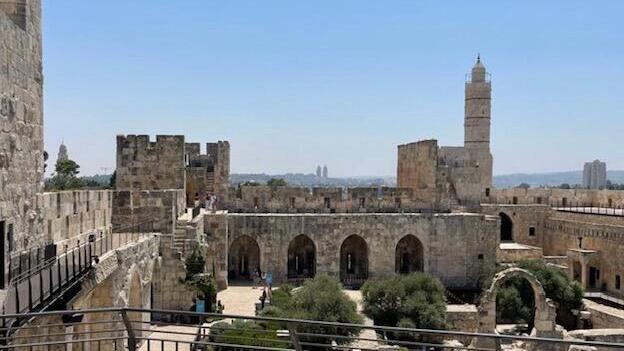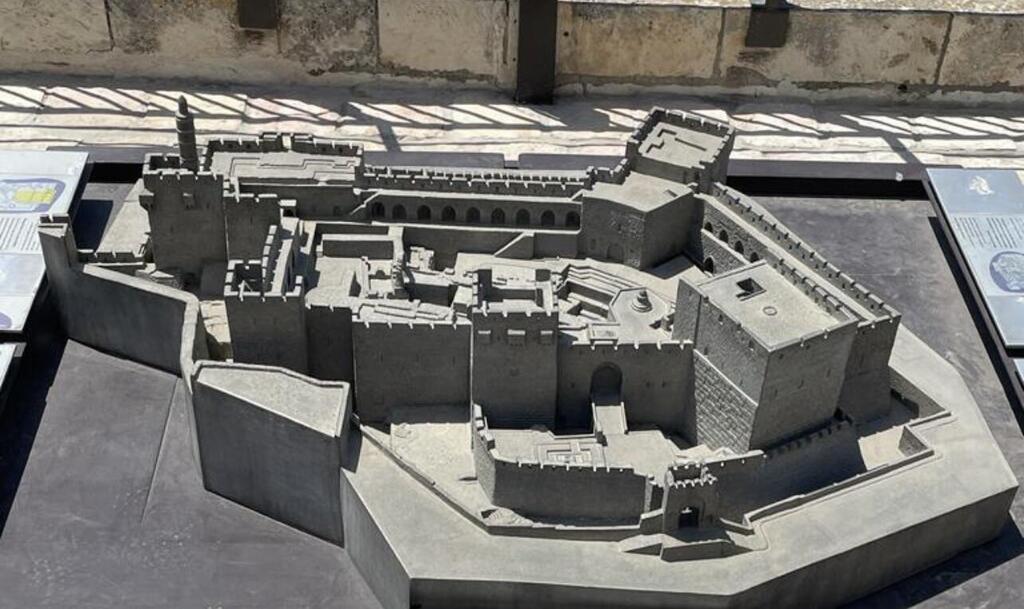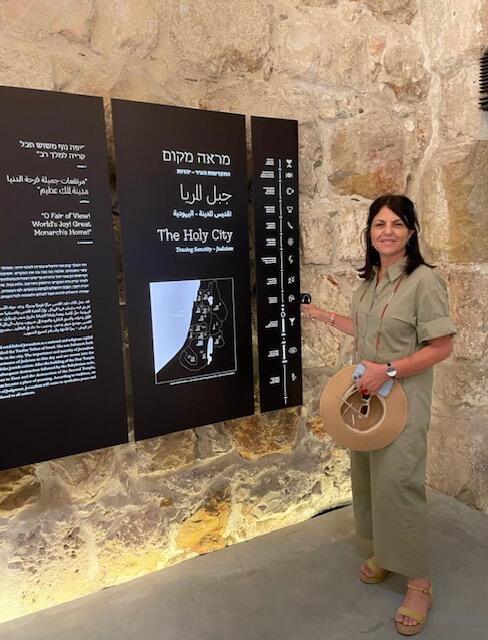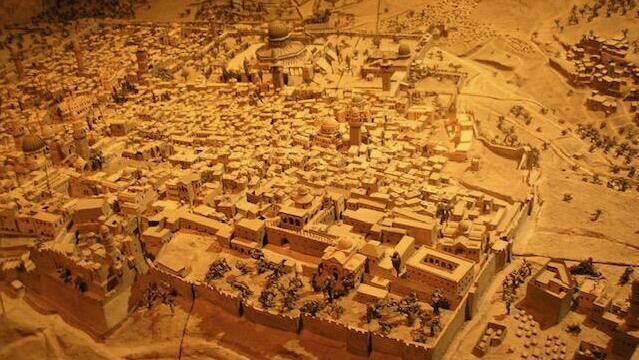Several landmarks in Jerusalem, bear the name of King David. There's a fortress tower known as David's Citadel, a tomb identified as his by the verse "And David slept with his fathers and was buried in the City of David." There's even a neighborhood named after him, as main thoroughfare called King David Street and two hotels bearing his name: "King David Hotel" and "David's Stronghold." But after 3,000 years of history, many questions remain in the enigmatic city.
Read more:
When the writer Yehuda Ha'ezrahi penned his book "Jerusalem, the City of My Choice," he began with a compelling question: "Where is the precise location of ancient Jerusalem? Of the fortress of Zion, which King David captured and named 'City of David' and which served as a capital for 33 years. Where are its gates? Where are its houses?"
It seems that today, many of these questions, posed over 50 years ago when Ha'ezrahi published his book, have definitive answers. Fifty years in the context of Jerusalem's 3,000-year history is a relatively short time, but now we have well-established answers to many of these inquiries which can be found prominently displayed in the new exhibition at the Tower of David Museum, a tower referenced in the Song of Songs by King Solomon: "Your neck is like the Tower of David, built with courses of stone; on it hang a thousand shields, all of them shields of warriors." (Song of Solomon 4:4)
The fortress as a museum
Shortly after General Allenby and his British armies, captured Jerusalem from the Ottomans in late 1917, the military governor of the city, Sir Ronald Storrs, took the initiative to establish a public organization called the "Society for the Preservation of Jerusalem," with the primary goal of conserving and restoring the city's historical assets, as well as fostering artistic talent and cultural development.
David's Citadel shed its military character and transformed into a center for cultural and artistic activities as part of Storrs' visionary project. Four years later, in 1921, the first exhibition was opened at David's Citadel, marking the first of annual exhibitions that continue to this day.
During the years 1927-1932, the "Association of Hebrew Artists" showcased both group and solo exhibitions at the Tower of David. One notable event was the 1924 solo exhibition of the painter Reuven Rubin "Everything Sings in Lines and Colors the Beauty of Life," a year after he had returned to the then Palestine. Israeli artists continued to exhibit their works there in the years that followed.
In the British Mandate, in 1935, residents of Jerusalem—Britons, Jews, and Arabs alike—established a Folklore Museum in the Old City. Its purpose was to preserve the arts and crafts of the Land of Israel. By 1941, the collection was relocated to two halls within the Tower of Hippicus at the Tower of David and became part of the general museum. Sir Edwin Samuel described the contents of that collection in a radio broadcast in November 1946: "The collection includes costumes of men and women, Arabs, and Bedouins of the Land of Israel. There are also some examples of clothing from Jewish Bukhara, Yemen, and Kurdistan... It also houses a collection of traditional tools used in the Land of Israel, as well as ceramics, jewelry, musical instruments, and weapons."
The reopening
In the 19 years between the War of Independence and the Six-Day War, the Tower of David served as a military base for the Jordanian army. The reunification of the city allowed it to become a central part of uniting the east and west parts of the city and placed it in equal importance with landmarks in the west such as the Knesset.
In 1983, the Tower of David was reopened. Following an extensive period of renovation and archaeological excavations, the museum was inaugurated as the "Museum of the History of Jerusalem." In the opening catalog, Professor Yehoshua Ben-Arie, a renowned Jerusalem scholar and recipient of the Israel Prize for his research, aptly said: "The Tower of David is, in essence, a miniature representation of the entire city. It encapsulates the historical past, the overall architectural structure, and both its external and internal beauty." He said that the various components of the citadel "combine to create an impressive completeness in its beauty, making the Tower of David one of the most historically captivating sites in the city of Jerusalem, and indeed, in the entire Land of Israel."
His profound description is evident in the recent permanent exhibition that opened a few months ago. After three and a half years of dedicated work by a team of 120 individuals and a substantial investment of $50 million much of it provided by the Klor Israel Foundation.
A crucial aspect of this remarkable achievement lies in the dedicated efforts of the museum's director, Eilat Lieber. As we navigate the museum's hidden staircases and passages during a guided tour, she says it was clear that the place required more than just refurbishment. "In fact, it called for a comprehensive restoration. Particularly, as extensive refurbishment was necessary in the tower, the displays in various rooms appeared outdated, not in line with modern museum standards, and, in compliance with laws and the spirit of the times, we needed to make the entire museum accessible."
The museum, redesigned according to plans by the award-winning architects Chyutin-Ashokolot and the internationally renowned exhibition designers Tal and Hanan de Lange, measures up to the standards of museums in the U.S. and other Western capitals, in the 21st century. Lieber guides us into the newly added, 700-meter (3000-foot) modern entrance hall, a significant addition to the large and historic Citadel building. Stepping into the hall, visitors can't help but feel like they are entering a regal edifice, fitting for a structure that partially stands on the Herodian Palace of Jerusalem from the time of the Second Temple.
The excavations of the Herodian Palace, long-delayed, were also part of this grand project. For the first time, visitors have the opportunity to descend into the depths of a royal palace that existed in Jerusalem over 2,000 years ago, mainly known to us through the writings of Roman historian Josephus Flavius. For centuries, the palace remained concealed beneath what was built upon it, including the Citadel, the Old City police headquarters and the space between the buildings and the city wall.
The new museum building
The museum comprises four main galleries. The first, "Jerusalem Through Time," features a prominent wall with 12 touchscreens displaying 85 different events from the city's history. It juxtaposes some 85 concurrent events from the broader world during the same periods. Upon their initial impressions and observations, many visitors are drawn to the events of the Great Revolt (70-66 CE) and seek to understand what had unfolded in those four years.
The other three galleries are organized around religions and beliefs, focusing on developments during the 19th and 20th centuries. For instance, in the Judaism hall, a unique architectural model of the Second Temple's Mount is displayed, known as the "Splendor of Jerusalem," as described by sages in relation to the city's beauty. The model vividly illustrates scenes that many are familiar with from historical texts about the history of Israel, the Land of Israel, and Jerusalem.
The Christian Hall follows the same theme, featuring a large model of the Church of the Holy Sepulchre, which was captured by the Crusaders from the Muslims in 1099. The figures in the model represent various roles within the church, offering a unique perspective of its interior. Much interest lies in the meticulous work done by Prof. Dan Bahat and Dr. Milka Rubin to supplement the Madaba Map (7th-6th centuries CE), which resides in the church in Madaba, Jordan. In his time, the late Prof. Yoram Tsafrir decoded the Madaba Map, and many visitors benefited from his research while visiting the church in Jordan. Now, you can clearly see how the map aids in understanding the Byzantine city, which has been excavated for over 50 years. The model of the Church of the Holy Sepulchre and the Madaba Map are focal points in the Christian hall.
The Islam hall continues along the same line, with a model of the Dome of the Rock on the Temple Mount and provides a unique perspective and allows for a closer look at various architectural elements, including artistic details, that may not always be immediately apparent when visiting the actual building. Since many Israelis may avoid visiting the actual structure, the model provides an opportunity to become familiar with this important building.
The new museum also houses a dedicated children's hall, entirely designed according to the work of David Kroyanker, the most significant Jerusalem architectural scholar. His 20 books serve as a treasure trove of information.
There is much to see at the Museum at the Tower of David, but one mustn't leave without gazing upon the unique and exceptional model known as the "Eilsh Model." It recreates Jerusalem as it appeared in the 19th century, precisely as it was envisioned by Bratislava-born cartographer Stephen Illesh. This remarkable model was commissioned by the Ottoman authorities and was hidden from public view for a long time. Its discovery and unveiling were made possible through the diligent research done by Motti Yair, who, at the time, was a student of Geography at the Hebrew University. With the assistance of Arian and David Litman, they uncovered the "Jerusalem from the Bird's Eye View" model. The model, which had traveled as far as Geneva, eventually found its way to the Tower of David Museum. For many years, it remained tucked away, hidden from view. However, in the museum's redesigned layout, the model receives the honor and significance it rightfully deserves.
The renewed museum, sprawling over 20,000 square meters, is the result of the dedicated efforts of many. Its creation involved a rare collaboration between private, governmental, and public entities, including the Jerusalem Municipality, the Ministry of Heritage, the Ministry of Tourism, the Patrick Drahi Foundation, the Phi Epsilon Foundation, the museum's friends, and the Heritage Fund. This exceptional partnership has enriched the State of Israel as a whole, and Jerusalem in particular, with a cultural, historical, and national asset unlike any other in the country today.





